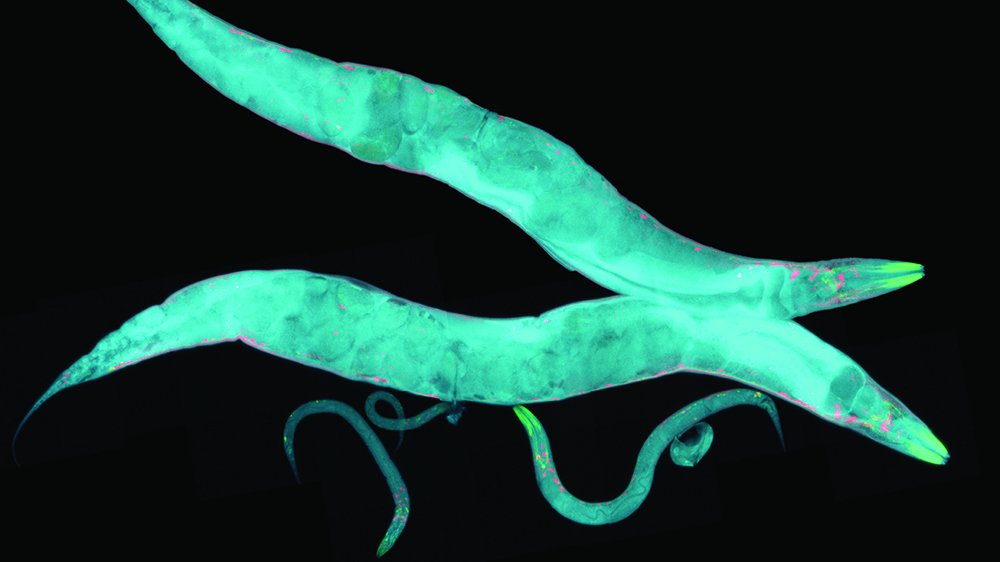MCP: Worms, too, slow down
in old age
In efforts to stave off death, unicellular and multicellular organisms constantly are recycling proteins, breaking down those that are damaged to provide building blocks for fresh copies that can carry out cellular functions. The process is an uphill battle with an inevitable end: The recycling and refreshing slow down, causing cellular damage to continue accruing until the organism dies and ultimately is broken into biochemical materials for other life. This progression, known as senescence, occurs in nearly every organism on Earth and has been studied extensively in the model organism Caenorhabditis elegans.

The roundworms’ decrease in protein turnover doesn’t occur evenly, however. Researchers at Ghent University in Belgium recently determined that two families of proteins involved in intracellular movement and reproduction are especially hard-hit in the worms.
“It’s not a uniform slowdown of the whole set of proteins,” said Ineke Dhondt, a postdoctoral researcher in the university’s Laboratory for Aging Physiology and Molecular Evolution. Dhondt and colleagues at the Pacific Northwestern National Laboratory in Washington recently described their findings in the journal Molecular & Cellular Proteomics. Previous papers in the field had determined that protein turnover in C. elegans decreases with age but hadn’t examined how significantly the effects varied between different families of proteins. “There are proteins that keep or retain their turnover,” Dhondt said. “That might be quite a different insight from other studies that only focus on the bulk protein turnover.”
C. elegans are widely used to study aging due to their short lifespan and well-characterized genomes. To examine which proteins were being turned over, the researchers fed subpopulations of the worms alternating samples of the bacteria Escherichia coli grown with either heavy or light nitrogen isotopes, characterizing the worms’ protein production with mass spectrometry before and after each meal over several days. The difference in isotope weights causes a slight weight difference in proteins that are subsequently synthesized, which can yield information about changes in protein production when compared with the previous spectrometer readings.
Dhondt and her colleagues found that the worms were decreasing their turnover of proteins in the tubulin and vitellogenin families, which are involved in cytoskeletal movement and production of eggs, respectively. They also found that ribosomal proteins, which are responsible for protein synthesis and all generally have a similar half-life, ended up varying widely in their turnover rates.
“We saw that these protein-turnover values really fan out over time,” Dhondt said. “That was an indication that this group might be important to dysregulation of the protein synthesis phenomenon, and that actually can be a key component to underlie aging.”
They also found that proteins responsible for protein degradation, such as the ubiquitin system, tended to continue their turnover throughout aging. “It’s like (the worms) want to keep up their function, so by refreshing these proteins, they want to make sure that these proteins keep functioning,” Dhondt said. “But in the end they’re fighting a battle that they can’t win, because the whole proteome will ultimately collapse.”
Dhondt and colleagues plan to continue studying aging in roundworms, with a new focus on the quality of health the worms exhibit into old age. “An important parameter for us is to look at the ability of the worms to move,” she said. “We are checking not only if the worms are living longer from a certain treatment but whether they are also exhibiting better health.”
Enjoy reading ASBMB Today?
Become a member to receive the print edition four times a year and the digital edition monthly.
Learn moreGet the latest from ASBMB Today
Enter your email address, and we’ll send you a weekly email with recent articles, interviews and more.
Latest in Science
Science highlights or most popular articles

Defining a ‘crucial gatekeeper’ of lipid metabolism
George Carman receives the Herbert Tabor Research Award at the ASBMB Annual Meeting, March 7–10, just outside of Washington, D.C.

The science of staying strong
Muscles power every movement, but they also tell the story of aging itself. Scientists are uncovering how strength fades, why some species resist it and what lifestyle and molecular clues could help preserve muscle health for life.

Bacteriophage protein could make queso fresco safer
Researchers characterized the structure and function of PlyP100, a bacteriophage protein that shows promise as a food-safe antimicrobial for preventing Listeria monocytogenes growth in fresh cheeses.

Building the blueprint to block HIV
Wesley Sundquist will present his work on the HIV capsid and revolutionary drug, Lenacapavir, at the ASBMB Annual Meeting, March 7–10, in Maryland.

Gut microbes hijack cancer pathway in high-fat diets
Researchers at the Feinstein Institutes for Medical Research found that a high-fat diet increases ammonia-producing bacteria in the gut microbiome of mice, which in turn disrupts TGF-β signaling and promotes colorectal cancer.

Mapping fentanyl’s cellular footprint
Using a new imaging method, researchers at State University of New York at Buffalo traced fentanyl’s effects inside brain immune cells, revealing how the drug alters lipid droplets, pointing to new paths for addiction diagnostics.

